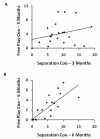Developmental changes of rhesus monkeys in response to separation from the mother
- PMID: 22213455
- PMCID: PMC3361565
- DOI: 10.1002/dev.21000
Developmental changes of rhesus monkeys in response to separation from the mother
Abstract
The development of separation response behaviors in infant rhesus macaques across the first 6 months of life was assessed. Seventeen infants underwent a neonatal assessment at 7, 14, 21, and 30 days of age which included a brief period of social isolation. At 3 and 6 months of age these same monkeys and four additional subjects were again subjected to a period of brief social isolation and also exposed to a novel environment with their sedated mother. Results indicate a developmental increase followed by a steady decline in the frequency of separation vocalizations. A modest relationship between early-infancy locomotor profiles and separation responses was also observed at several time points suggesting a possible relationship between these measures. However, stable inter-individual measures of separation distress did not emerge until late in the infantile period. This could suggest that high levels of maternal contact-seeking behavior early in infancy are context specific and not a reliable index of enduring temperament.
Copyright © 2011 Wiley Periodicals, Inc.
Figures




References
-
- Barr RG. The normal crying curve: what do we really know? Dev Med Child Neurol. 1990;32(4):356–362. - PubMed
-
- Berman CM. Mother-infant relationships among free-ranging rhesus monkeys on Cayo Santiago: A comparison with captive pairs. Animal Behaviour. 1980;28(3):860–873.
-
- Bethea CL, Streicher JM, Coleman K, Pau FK, Moessner R, Cameron JL. Anxious behavior and fenfluramine-induced prolactin secretion in young rhesus macaques with different alleles of the serotonin reuptake transporter polymorphism (5HTTLPR) Behav Genet. 2004;34(3):295–307. - PubMed
Publication types
MeSH terms
Grants and funding
LinkOut - more resources
Full Text Sources

